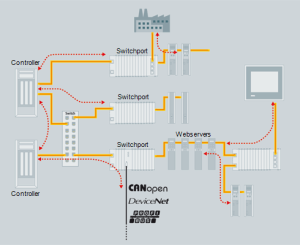EtherCAT Features
![]() ***EtherCAT is an open, high-performance Ethernet-based fieldbus system. The development goal of EtherCAT was to apply Ethernet to automation applications which require short data update times (also called cycle times) with low communication jitter (for synchronization purposes) and low hardware costs is characterized by outstanding performance, very simple wiring, and openness to other protocols. EtherCAT sets new standards where conventional fieldbus systems reach their limits:
***EtherCAT is an open, high-performance Ethernet-based fieldbus system. The development goal of EtherCAT was to apply Ethernet to automation applications which require short data update times (also called cycle times) with low communication jitter (for synchronization purposes) and low hardware costs is characterized by outstanding performance, very simple wiring, and openness to other protocols. EtherCAT sets new standards where conventional fieldbus systems reach their limits:
- 1000 I/Os in 30 µs.
- Optionally twisted-pair cable or optical fiber.
- Optimum vertical integration (thanks to Ethernet
 Ethernet is a large, diverse family of frame-based computer networking technologies that operate at many speeds for local area networks (LANs) and Internet technologies).
Ethernet is a large, diverse family of frame-based computer networking technologies that operate at many speeds for local area networks (LANs) and Internet technologies).
With EtherCAT, the costly Ethernet star topology is replaced with a simple line structure - no expensive infrastructure components are required.
- Optionally, EtherCAT can be wired in the classic way using switches, to integrate other Ethernet devices.
- Where other real-time Ethernet approaches require special connections in the controller, for EtherCAT, very cost-effective standard Ethernet cards suffice.
EtherCAT is Versatile
These communication connections are supported (see image):
- Master to Master
- Master to Slave
- Slave to Slave
Figure 9-52: Versatile Network Architecture
Safety over EtherCAT is Available
- EtherCAT makes Ethernet down to the I/O level technically feasible and economically sensible.
- Outstanding features of this network include:
- Full Ethernet compatibility.
- Internet technologies (even in simple devices).
- Maximum utilization of the large bandwidth
 In computer networking, bandwidth often refers to a data rate measured in bits/s, for example, network throughput. The reason for the connection of data rate with the term bandwidth is that the limit to the data rate of a physical communication link is related to its bandwidth in hertz offered by Ethernet.
In computer networking, bandwidth often refers to a data rate measured in bits/s, for example, network throughput. The reason for the connection of data rate with the term bandwidth is that the limit to the data rate of a physical communication link is related to its bandwidth in hertz offered by Ethernet. - Outstanding real-time characteristics at low costs.







